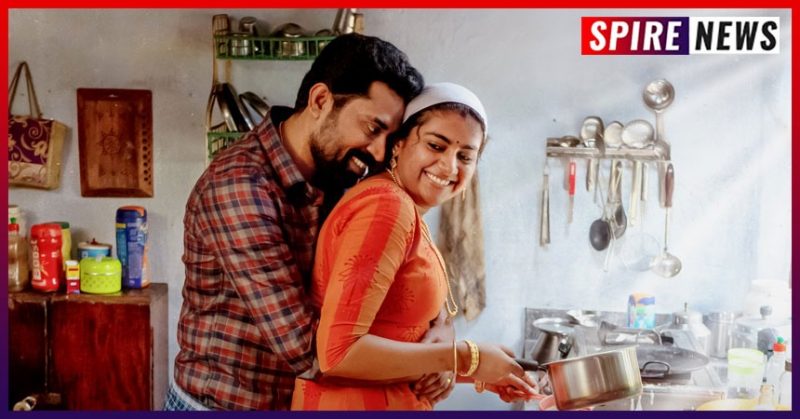The Great Indian Kitchen aka Mahaththaya Bharatiya Adukkala by writer-director Jeo Baby is a Great Indian Film that portrays an under-discussed horrible reality with astounding precision by simply duplicating on screen what happens in millions of Indian households. Although it is in Malayalam, the title reminds us that patriarchy knows no bounds. The characters don’t have names since they are you, me, and everyone else.
Because there is no tale to convey, here is a synopsis of the first 9 minutes. In The Great Indian Kitchen, Nimisha Sajayan plays a dancer. Her family is preparing for a pennu kaanal as the film begins (a potential groom coming to see a girl for an arranged marriage). The character of Suraj Venjaramoodu appears. He is the planned husband. We’ve seen her house and family, but we know nothing about him, his occupation, or financial background in those early scenes, except for snippets of a quick dialogue hinting that he comes from a prestigious family.
Making of The Great Indian Kitchen
Venjaramoodu, Nimisha’s senior co-star from Thondimuthalum Driksakshiyum, demonstrates extraordinary artistic intelligence by playing The Great Indian Kitchen’s Husband as a seemingly diffident Everyman with a nice-guy demeanour whose regressive attitudes emphasise the fact that villains are usually the regular people living next door.
All technical departments, from the supervision and detail of the sound designer Tony Babu’s detailed palette of swishes, trickles, bubbling oils and man-made mouths that crush food, and the shooting of the leading lady in the dimly-lit marital prison to the glorious final with its explosion of brightness and light, complement the understated nature of their works. Francies Louis, the film’s editor, ensures that every single shot counts.
And Dhanya Balakrishnan clothes the actors in costumes that provide a wide selection of insight into the Malayali culture, till she is able to release her imaginations to this sumptuous concluding scene. Even the top-notch subtitles don’t falter.
One of the many unforgettable moments in The Great Indian Kitchen is when a woman weaponizes a man’s belief that menstruation makes her dirty. Take that, patriarchy! Take that!
Some Discussions
Having said that, the film does falter slightly in its discussion of menstruation. Of course, it is abhorrent that a woman is considered a pollutant when she is menstruating, but The Great Indian Kitchen overlooks an important nuance: unlike this film’s heroine, many women suffer from aches and shooting pains in addition to heavy bleeding, and forced segregation in homes that consider them impure at this time of the month is, ironically, the only way they get the rest they so desperately need.
In a Mollywood that has a tendency to normalise domestic violence (recent examples include Aadya Rathri and Ayyappanum Koshiyum), The Great Indian Kitchen demonstrates how horrifying facts can be depicted without being casual about them. (Slight spoiler ahead) It also demonstrates progressive layering, as demonstrated by a Hindu guy who has no issues about eating beef in his home but also has no reservations about his wife serving food to family and guests while he sits around being served.
Societal Matters in the Great Indian Kitchen
This also brings up another aspect of Indian society – family support – that is ceaselessly romanticised while its corrupt aspects are ignored: the fact that Indian families go out of their way to support one another is admirable, but that is no reason to ignore the uncomfortable reality that this culture is routinely abused to take advantage of considerate relatives. (The spoiler alert has come to an end.)
The Great Indian Kitchen is a shocking, scathing, and astounding critique of patriarchy and its ever-present sidekick, religion. The fact that Jeo Baby does so much with such a simple story, one that has been staring us all in the face our entire lives, is what makes it such a piece of genius.


